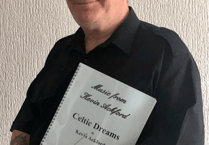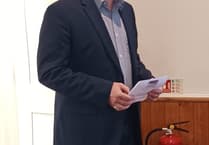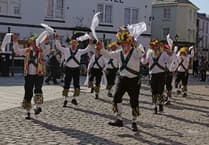FROM Shropshire to Cornwall — how a local researcher came to love Launceston.
‘It’s like going to lots of restaurants and having a different meal every time’ — that’s how 87-year-old Jim Edwards describes his lifelong love for history.
Launceston is lucky enough to be home to a handful of historians and researchers, those who are willing to share their findings with the local and wider public, including good friend to the town’s late famous poet Charles Causley, Arthur Wills, and Jim.
Jim moved to Launceston in 1963 from Shropshire after meeting a young lady named Liz whilst working in the area.
He told the Post: “I’d been down here several years before I was married, I went to about two or three different towns because of my work.”
Jim worked for a building company, laying foundations for different settlements around the whole of the UK. “I’ve travelled all over the country, from Land’s End to John O’Groats,” he continued. “I had three jobs, close to here, and one was near Lewdown when there was a drivers’ cafe — which the comedian Jethro bought later.
“I came out one morning for breakfast, and there was a maid with an axe, stuck in a log. I said, ‘Give me the axe, dear’ and I just split a few logs for her. She said, ‘Thank you very much’, and off she went with her wheelbarrow. I asked her, ‘What are you doing later?’ and she said she would be working in the kitchen with two other girls. I had my supper, and then I went in and chatted with them — there were two sisters, and then there was Liz, who I had helped earlier on. She obviously fell for it!
“I got to know her at home, and then she got a job at a brush factory, just down the road here. I met her at Christmas, 1962, and then it was April 1, ‘63, when I came here to stop, and we married in ‘67. We had Angie in ‘69, and Carol in ‘71.”
Jim has always been interested in history, and says his former job working for a Shropshire-based settled buildings company gave him ‘a good frame of geology too’, adding: “I got to know where and how to build trenches and all sorts.”
He continued: “I was just fascinated about people from the past. I’ve only just finished putting a bit together for the new tourist information centre officer (in Launceston), who is very interested in the history of the town.”
Having been in the army himself in his younger years, Jim has always been interested in Launceston’s military past. “I picked up on several heroes — and I mean heroes. There was three or four pastors or vicars who went to the front line, and there was a dentist who trained at the college — he was the only dental surgeon who won a DC.
“It’s people who did something. I found out about the Thomson family, who provided three generations of doctors — people like that who have done things in life, they really interest me. There’s just so much of it, too.”
Having lived in Launceston since the early 60s, and researching the town’s past, Jim has come to know the extent of how much the town has changed over the years. “The worst thing they could have done was when they did away with the stage coaches. They began to drop off, and then by 1900, there was just three blacksmiths in the area. Of course, when the trains were stopped too, that was a big thing because a lot of the people who worked on them had wives and families of their own,” he added. “Everything changes, and we know it’s got to change.”
As he hit retirement age, Jim began making regular visits to Launceston Library to read up on the town. He said: “I just wanted to look for a book in the library — there were thousands of them, all about a 20-mile radius of Lanson, which is huge really.
“I’m still collecting now, it’s so interesting. It’s like going to lots of restaurants and having a different meal every time!”
Even by having one conversation with Jim, you will come away feeling as though you have gained an entire history lesson’s worth of knowledge. He spoke about how in a 1923 edition of the Times, four years after the end of the First World War and just six or seven years before Adolf Hitler came onto the political scene, there was an admiral who spoke at parliament about the building of docks and battleships at Singapore, claiming that it would be a ‘waste of time’ to get involved with it and it was never built. “It would have been a great advantage to us,” Jim added.
Military history has always been at the forefront of Jim’s historic interests, and it stemmed from his time at school in Wem, Shropshire. He said: “I was very lucky, really. In the first week or two of senior school, there was two classes taught in one class for a time. Then Mr Edwards came along who was in the RAF at the beginning of the war. He’d got caught in a hurricane and hurt his back, so took up teaching instead as he was no longer fit to serve.
“It was on D-Day morning that he came in, picked up a piece of chalk and began drawing squiggly lines up on the chalkboard. It was later when he told us that he was drawing up a map of northern France, and day-by-day he would update us by drawing on his map. I found it absolutely fascinating — I’d always been into the old cowboys and Indians stories.”
Although he lived in wartime Britain, Jim said he and his local community in a small area of Shropshire were not so affected by the war. He said: “We lived in a place very similar to North Petherwin. My father worked on the farms there — we had fresh milk, a few turnips, our own chickens and pigs. You had to have a licence to slaughter pigs back then, and early in January we slaughtered a pig. Our neighbours slaughtered their pigs in October-November time, so we had pork and livers — we had a share of that and then when it was our turn, they’d get a share of that. My mother had orchards so she did lots of jam making and bred chickens so we had plenty of chicken food. We lived pretty well.”
Jim lived with two brothers and two sisters — one of his brothers is still alive and living in Shropshire, and recently won a paid-for ten-day holiday to Australia and Singapore, another area of the world that Jim, too, has experienced from his days spent in the army.
Jim spent two to three years in the light infantry, and within three months was given his stripe and ordered into shift work, completing 36-hour days in the office. “You soon got used to it,” he laughed. “I enjoyed it all. We got to do parades and all sorts.
“You’d be in the office with orders and letters, only the diplomatic stuff came through to us. When I got to be corporal — because our sergeant had run out of his time — I was put in charge of the shift and my security was suddenly updated. I only found this out later with letters from home, and I had got right to the top in security.
“Most of us could see the top secret stuff, just the runners couldn’t see it. When something came in as top secret, the shift manager would have to type it out in secret and then dispose of it in secret. I came out in the end, and then had nine years to do in the reserve.”
Eventually Jim’s workforce had to join a union in relation to typing and office work. “I wouldn’t join, and then it came about that there was two redundancies. I was the last to join, but was second senior, and became the next senior. After that there was a lot of fighting and arguing; I got fed up and handed in my notice. Altogether I’ve had a fairly busy life!”
Jim said how important it is to recognise the history of an area, and ensure it is accurate. “It pays to be honest to people and tell people, oh, I don’t know that,” he said.
He presented a letter from the Drake family from Jekyll Island, Georgia, USA from March 2001, after helping the family connect with distant cousins from Stoke Climsland and Dorset. As an added fact, he said: “I knew they weren’t related to Sir Francis Drake (the famous seaman from Tavistock) because he never had a coat of arms, his family were all farmers. But he stole one from the other Drake family in Dorset!”
He also received word from the Central Library, who said they had no information on any artists from North Cornwall. “I had (Robert) Whale of Altarnun and the Colliers. They didn’t know about either of those, so asked if I would let them have the information.”
Jim had a copy of a Collier painting from the 1800s, illustrating Summerleaze beach in Bude, with two figures — perhaps a donkey and a person fishing for carp — with the initials ‘ABC’ scribbled in the right-hand bottom corner.
“They were all RA (Royal Academy) artists — we’ve had these people here. They might not be heroes, but they’re still as good as anybody else.”
As well as taking countless trips to Launceston Library, helping local man Roger Pyke with the Launceston Then website and providing the Post with regular information, Jim also spends much of his spare time as a volunteer at Launceston’s Lawrence House Museum. He lives at home with his wife Liz and their collie, Dusty.
Approximately five or six years ago, Roger Pyke created the Launceston Then website, and Jim was crucial to the website’s content, which provides people with all they need to know about Launceston — its people, places, crimes, stories and culture.
Roger said: “I have known Jim off and on for more years that I care to remember, being that we both lived in Egloskerry. However, it was during my many hours spent up at the library researching the world war fallen from Launceston, that we truly became entangled.
“The library, as many will know, is almost Jim’s second home and I got talking to Jim about all his research on the town and what he intended on doing with it. ‘Nothing’, was his reply, to which I uttered these words that would come back to almost haunt me — ‘Well, why don’t we combine both of our research and put together a little website on the history of Lanson?’
“What I had let myself in for was putting together all of Jim’s ‘bits and pieces’ that were contained on copious floppy discs, flash drives and good old paper and today we have a website that is over 600 pages in size, containing literally thousands of images and stories. And just when I think we have completed the project of our ‘little website’, I’ll get a call from Jim saying he’s got some more ‘bits and pieces’ for me.”
Roger called Jim ‘The Oracle’ because of his extensive knowledge of ‘Lanson’ and its people. He added: “I am proud to be associated with him and of being able to put his hard work together for others to enjoy. Launceston Then stands as a real sentiment to The Oracle’s hard work.”
Jim is a real asset to the Launceston community. Not only has he provided vital information to the people of Launceston, but he has brought families together with distant relatives and ensures Launceston’s past and history is preserved for years to come.
To find out more about the history of Launceston and its people, visit Roger and Jim’s website, www.launcestonthen.co.uk




